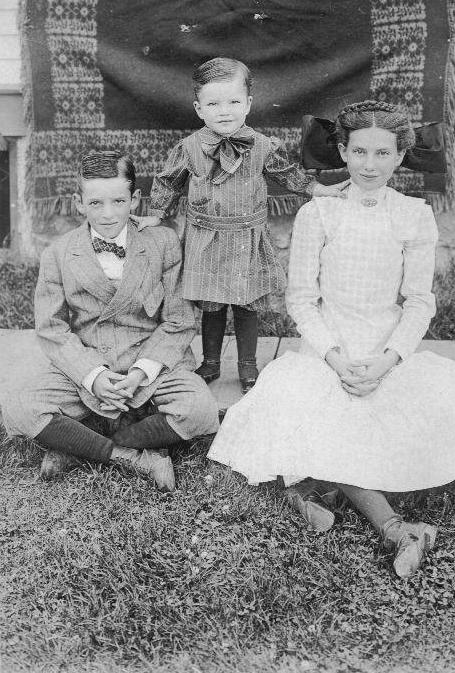
United States Boys' Clothes Chronology: Early 20th Century Garments

Figure 1.--Here we see an AZO postcard back snap shot of three children, presumably siblings. The children wear some classic style of the early-20th century. The little boy wears a striped tunic suit with a floppy bow and matching bloomer knickers. He has strap shoes. The bow is much smaller than worn earlier. The older boy wears a double-breasted knickers suit with a bow-tie. Their big sister wears a light-colored print dress with a huge hair bow-hard to see becaise it is a dark color. The older childrebn wear high-top shoes. All the children wear long stockings. Mother seems to have hubg out a quilt as a back drop. white dress.
|
|
There are some particularly notable styles worn by American boys in the early-20th century. The early 1900s was a watershed period in American boys' fashions. The old formal styles were still worn at the turn of the century, but the new more casual styles had begun to appear by the 1910s. We see boys wearing a range of caps and some hats in the 1900s, but by 1910 the flat cap had become the standard style. We still see boys wearing dresses and kilt-suits at the turn of the century, but both styles were rapidly declining. Tunics were very popular, especially for pre-school boys. They were done in a range of styles. Fauntleroy suits wete still worn, but like kilt-suits were rapidly passing out of style. Sailor suits, however, cbntunued to be very popular in the early-20th century. The sailor stle by the lare-1910sas was beginining to be seen as a style for little boys. Boys in the 1900s still wore knee pants as thry had dome for several decades. The knee pants that predominated before the war had began to be replaced with knickers and to a lesser extent short pants. Most boys continued wearing knee pants suits during the 1910s, but this changed rther abtuptly about 1908-10. Suddenly boys began wearing knickers which became as standard as knee pants had become. And at about the same time we see boys wearing overalls. Coveralls appeared for city boys. Both boys and girls continued wearing long stockings. Closed-toe sandals appeared, but did not prove as popular as in Britain. Younger boys wore strap shoes like girls. High-top shoes continued to be worn by school age boys.
Flat Caps
We see boys wearing a range of caps and some hats in the 1900s, but by 1910 the flat cap had become the standard style. Virtally every American boy had a flat cap. They were worn by both news boys and boys dressing up in knicker suits.
Kilt Suits
We still see boys wearing dresses and kilt-suits at the turn of the century, but both styles were rapidly declining.
Tunic Suits
Tunics were very popular, especially for pre-school boys, but we see boys as ols=d as 8years old wearing them. . They were done in a range of styles. Tunics were worn throughout the 19th century., but they seem particularly popular in the early-20th century. They were the last popular skirted garment for boys. We see a variety of styles, Byster Brown outdfits, Russian blouses, and sailor styles. They were worn both for play and when dressing up. White was poplar during the sumer, but there were also colors and patterns. There seems to have been a social-cass factor.
Fauntleroy Suits
Little Lord Fauntleroy suits were still popular. After the turn of the century Fauntleroy suits with short pants (rather than kneepants) began to appear and
were increasingly worn with white stockings or
white kneesocks. The size of the jackets increased to cover the blouse entirely. In addition large lace collars began to be replaced with ruffled collars and smaller bows. Some ruffled collars were wore with
open necks. Increasinly kneepants and long stockings were replaced with either shortpants or
knickers worn with kneesocks. Shortpants became particularly popular
in Britain and Europe while knickers became more popular in America.
Sailor Suits
Sailor suits continued to be a very popular style after the turn of the century. The style by the 1910s, however, eas beginining to become a fashion for little boys. The kneepants that predominated before the war had began to be replaced with knickers and to a lesser extent short pants.
Suits
Boys wore a variety of suit styles in the early-20th century. We see both single- and double-breasted jacket, both mostly worn with knee pants in the 1900s. Norfolk jackets worn with knockers became a classic style for boys in the 1910s.
Pants
Boys in the 1900s still wore knee pants as thry had dome for several decades. The knee pants that predominated before the war had began to be replaced with knickers and to a lesser extent short pants. Most boys continued wearing knee pants suits during the 1910s, but this changed rather abtuptly about 1908-10. Suddenly boys began wearing knickers which became as standard as knee pants had become. Younger boys continued wearing knee pants for a while and the style grduallyv evolved into short pants.
Overalls
And at about the same time we see boys wearing overalls. Coveralls appeared for city boys.
Hosiery
Both boys and girls continued wearing long stockings. Younger children might wear socks, often white socks.
Footwear
Closed-toe sandals appeared, but did not prove as popular as in Britain. Younger boys wore strap shoes like girls. High-top shoes continued to be worn by school age boys.There are some particularly notable styles worn by American boys in the early-20th century.
HBC

Navigate the Boys' Historical Clothing Web Site:
[Return to the Main U.S. early 20th century page]
[Return to the Main U.S. Country Page]
[Introduction]
[Activities]
[Biographies]
[Chronology]
[Clothing styles]
[Countries]
[Bibliographies]
[Contributions]
[FAQs]
[Glossaries]
[Images]
[Links]
[Registration]
[Tools]
[Boys' Clothing Home]
Created: 4:43 AM 3/31/2013
Last updated: 2:04 PM 1/25/2018



